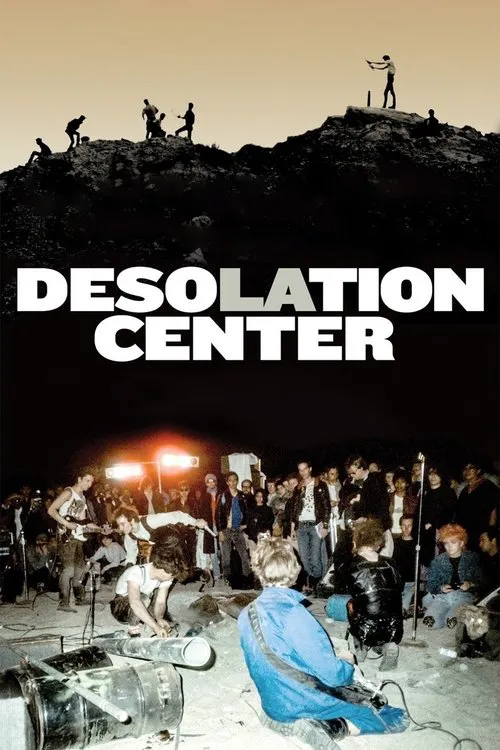Desolation Center

Plot
In the early 1980s, California was experiencing a period of social and artistic upheaval, marked by the ascension of President Ronald Reagan and the proliferation of a growing anti-establishment movement. It was during this time that a series of underground, avant-garde music and art events began to take shape in the desert landscapes of Southern California. These events, which would come to be known as the Desert Happenings, served as a catalyst for the counterculture movements of the time, influencing the development of contemporary festivals like Burning Man, Lollapalooza, and Coachella. At the forefront of this movement was Genesis P-Orridge, a British artist and musician who, along with his partner, Lady Jaye Breyer, founded the experimental rock group Throbbing Gristle. P-Orridge's influence on the avant-garde music scene was immense, and he quickly became a key figure in the development of Desert Happenings. In 1984, P-Orridge organized the first Desolation Center event, which took place in the Mojave Desert near the city of Joshua Tree. This event was a groundbreaking spectacle that combined music, performance art, and experimental technology, setting the stage for the subsequent Desert Happenings. The Desolation Center events were a space for artists and musicians to push the boundaries of their respective crafts, often incorporating elements of industrial music, noise, and performance art. The gatherings featured a diverse array of acts, including Sonic Youth, the Minutemen, Meat Puppets, and Redd Kross, all of whom were known for their innovative and uncompromising approaches to music. These bands, along with others, were united by their desire to challenge the mainstream music industry and create a new, more experimental sound. One of the key factors that set the Desolation Center events apart from other music festivals of the time was their emphasis on experimental technology and avant-garde art. Artists like Einstürzende Neubauten, a German industrial music group known for their use of found objects and machinery in their performances, and Survival Research Laboratories, a collective that combined music, performance art, and experimental technology, helped to create an atmosphere of chaos and unpredictability. This was a space where the lines between art, music, and technology were blurred, and where the boundaries of what was considered "acceptable" were constantly being pushed. The Desolation Center events also provided a platform for underground and avant-garde bands to showcase their work, often in the face of intense opposition from the mainstream music industry. The gatherings were a testament to the power of grassroots, DIY (do-it-yourself) music and art, where artists and musicians were able to create their own opportunities and take control of their own destinies. This spirit of defiance and resistance was infectious, attracting participants from all over the country who were eager to experience the energy and creativity of the Desert Happenings. One of the key figures to emerge from this scene was Glenn Branca, an American composer and guitarist known for his work in the avant-garde and punk rock scenes. Branca's use of extended guitar techniques and large-scale orchestral pieces helped to push the boundaries of what was possible in the realm of noise and avant-garde music. His work with Sonic Youth, which he would go on to mentor in the late 1980s, helped to cement his status as a key figure in the development of underground and avant-garde music. The Desolation Center events also drew attention to the work of artists and musicians who were experimenting with noise and industrial music. Artists like Swans, a group known for their use of distorted guitars and haunting vocal melodies, and Savage Republic, a collective that combined music with experimental technology and performance art, helped to create a sonic landscape that was both challenging and cathartic. Despite the influence and impact of the Desolation Center events, they were largely unknown to the wider public, existing on the fringes of the mainstream music scene. It was not until the 1990s, with the rise of alternative rock and the proliferation of electronic and experimental music, that the legacy of the Desert Happenings began to gain wider recognition. The Desolation Center events were not without their challenges, however. The gatherings often drew controversy, with some participants accusing the organizers of exploiting the desert landscape and disrupting the tranquility of the surrounding communities. Additionally, the harsh desert conditions and limited access to amenities made the events challenging to produce and participate in. Despite these challenges, however, the Desolation Center events continued to thrive, providing a space for artists and musicians to push the boundaries of their respective crafts and challenge the status quo. Today, the influence of the Desolation Center events can be seen in a wide range of contemporary music festivals and events. Burning Man, a week-long gathering in the Nevada desert, is perhaps the most notable example, with its emphasis on experimental technology, avant-garde art, and performance. Lollapalooza and Coachella, while not explicitly linked to the Desolation Center events, also owe a debt to the pioneering spirit and willingness to experiment that characterized the Desert Happenings. As the Desolation Center events demonstrate, the power of grassroots, DIY music and art lies in its ability to challenge the status quo and create new opportunities for creativity and self-expression. By embracing experimentation and pushing the boundaries of what is possible, the Desolation Center events left a lasting impact on the music and art world, one that continues to be felt today.
Reviews
Recommendations



